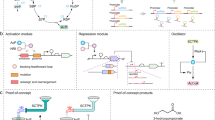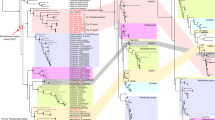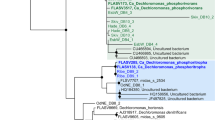Abstract
Enhanced biological phosphorus removal (EBPR) activated sludge communities enriched in ‘Candidatus Accumulibacter’ relatives are widely used in wastewater treatment, but much remains to be learned about molecular-level controls on the EBPR process. The expression of genes found in the carbon and polyphosphate metabolic pathways in Accumulibacter was investigated using reverse transcription quantitative PCR. During a normal anaerobic/aerobic EBPR cycle, gene expression exhibited a dynamic change in response to external acetate, oxygen, phosphate concentrations and probably internal chemical pools. Anaerobic acetate addition induced expression of genes associated with the methylmalonyl-CoA pathway enabling the split mode of the tricarboxylic acid (TCA) cycle. Components of the full TCA cycle were induced after the switch to aerobic conditions. The induction of a key gene in the glyoxylate shunt pathway was observed under both anaerobic and aerobic conditions, with a higher induction by aeration. Polyphosphate kinase 1 from Accumulibacter was expressed, but did not appear to be regulated by phosphate limitation. To understand how Accumulibacter responds to disturbed electron donor and acceptor conditions, we perturbed the process by adding acetate aerobically. When high concentrations of oxygen were present simultaneously with acetate, phosphate-release was almost completely inhibited, and polyphosphate kinase 1 transcript abundance decreased. Genes associated with the methylmalonyl-CoA pathway were repressed and genes associated with the aerobic TCA cycle exhibited higher expression under this perturbation, suggesting that more acetyl-CoA was metabolized through the TCA cycle. These findings suggest that several genes involved in EBPR are tightly regulated at the transcriptional level.
Similar content being viewed by others
Log in or create a free account to read this content
Gain free access to this article, as well as selected content from this journal and more on nature.com
or
References
Ahn J, Schroeder S, Beer M, McIlroy S, Bayly RC, May JW et al. (2007). Ecology of the microbial community removing phosphate from wastewater under continuously aerobic conditions in a sequencing batch reactor. Appl Environ Microbiol 73: 2257–2270.
APHA (1995). Standard Methods for the Examination of Water and Waste Water. Washington, DC: American Public Health Association, American Water Works Association and Water Environment Federation: Washington, DC.
Barnard JL, Abraham K . (2006). Key features of successful BNR operation. Water Sci Technol 53: 1–9.
Brdjanovic D, Slamet A, van Loosdrecht MCM, Hooijmans CM, Alaerts GJ, Heijnen JJ . (1998). Impact of excessive aeration on biological phosphorus removal from wastewater. Water Res 32: 200–208.
Burow LC, Mabbett AN, Blackall LL . (2008). Anaerobic glyoxylate cycle activity during simultaneous utilization of glycogen and acetate in uncultured Accumulibacter enriched in enhanced biological phosphorus removal communities. ISME J 2: 1040–1051.
Comeau Y, Hall KJ, Hancock REW, Oldham WK . (1986). Biochemical model for enhanced biological phosphorus removal. Water Res 20: 1511–1521.
Crocetti GR, Hugenholtz P, Bond PL, Schuler A, Keller J, Jenkins D et al. (2000). Identification of polyphosphate accumulating organisms and the design of 16S rRNA-directed probes for their detection and quantitation. Appl Environ Microbiol 66: 1175–1182.
Garcia Martin H, Ivanova N, Kunin V, Warnecke F, Barry KW, McHardy AC et al. (2006). Metagenomic analysis of two enhanced biological phosphorus removal (EBPR) sludge communities. Nat Biotechnol 24: 1263–1269.
Gavigan JA, Marshall LM, Dobson ADW . (1999). Regulation of polyphosphate kinase gene expression in Acinetobacter baumannii 252. Microbiology-Uk 145: 2931–2937.
Guisasola A, Pijuan M, Baeza JA, Carrera J, Casas C, Lafuente J . (2004). Aerobic phosphorus release linked to acetate uptake in bio-P sludge: process modeling using oxygen uptake rate. Biotechnol Bioeng 85: 722–733.
Gunsalus RP, Park SJ . (1994). Aerobic-anaerobic gene regulation in Escherichia coli: control by the ArcAB and Fnr regulons. Res Microbiol 145: 437–450.
He S, Gu AZ, McMahon KD . (2006). Fine-scale differences between Accumulibacter-like bacteria in enhanced biological phosphorus removal activated sludge. Water Sci Technol 54: 111–117.
He S, Gall DL, McMahon KD . (2007). ‘Candidatus Accumulibacter’ population structure in enhanced biological phosphorus removal sludges as revealed by polyphosphate kinase genes. Appl Environ Microbiol 73: 5865–5874.
He S, Gu AZ, McMahon KD . (2008). Progress toward understanding the distribution of Accumulibacter among full-scale enhanced biological phosphorus removal systems. Microb Ecol 55: 229–236.
He S, Kunin V, Haynes M, Martin HG, Ivanova N, Rohwer F et al. (2010). Metatranscriptomic array analysis of ‘Candidatus Accumulibacter phosphatis’-enriched enhanced biological phosphorus removal sludge. Environ Microbiol 12: 1205–1217. Epub 2010 Feb 9.
Hesselmann RPX, Werlen C, Hahn D, van der Meer JR, Zehnder AJB . (1999). Enrichment, phylogenetic analysis and detection of a bacterium that performs enhanced biological phosphate removal in activated sludge. Syst Appl Microbiol 22: 454–465.
Hesselmann RPX, von Rummell R, Resnick SM, Hany R, Zehnder AJB . (2000). Anaerobic metabolism of bacteria performing enhanced biological phosphate removal. Water Res 34: 3487–3494.
Kato J, Yamamoto T, Yamada K, Ohtake H . (1993). Cloning, sequence and characterization of the polyphosphate kinase-encoding gene (ppk) of Klebsiella aerogenes. Gene (Amsterdam) 137: 237–242.
Kong Y, Nielsen JL, Nielsen PH . (2004). Microautoradiographic study of Rhodocyclus-related polyphosphate-accumulating bacteria in full-scale enhanced biological phosphorus removal plants. Appl Environ Microbiol 70: 5383–5390.
Kornberg HL . (1966). Role and control of glyoxylate cycle in Escherichia coli - The first Colworth Medal Lecture. Biochem J 99: 1–11.
Korner H, Zumft WG . (1989). Expression of denitrification enzymes in response to the dissolved-oxygen level and respiratory substrate in continuous culture of Pseudomonas stutzeri. Appl Environ Microbiol 55: 1670–1676.
Li BK, Bishop PL . (2004). Micro-profiles of activated sludge floc determined using microelectrodes. Water Res 38: 1248–1258.
Louie TM, Mah TJ, Oldham W, Ramey WD . (2000). Use of metabolic inhibitors end gas chromatography/mass spectrometry to study poly-beta-hydroxyalkanoates metabolism involving cryptic nutrients in enhanced biological phosphorus removal systems. Water Res 34: 1507–1514.
Lynch AS, Lin ECC . (1996). Response to molecular oxygen. In: Neidhardt FC, Curtis R, Ingraham JL, Lin ECC, Low KB, Magasanik B et al (eds). Escherichia coli and Salmonella: Cellular and molecular biology. American Society for Microbiology: Washington DC, pp 1526–1538.
Maurer M, Gujer W, Hany R, Bachmann S . (1997). Intracellular carbon flow in phosphorus accumulating organisms from activated sludge systems. Water Res 31: 907–917.
McMahon KD, Dojka MA, Pace NR, Jenkins D, Keasling JD . (2002). Polyphosphate kinase from activated sludge performing enhanced biological phosphorus removal. Appl Environ Microbiol 68: 4971–4978.
Menon S, Ragsdale SW . (1997). Mechanism of the Clostridium thermoaceticum pyruvate:ferredoxin oxidoreductase: evidence for the common catalytic intermediacy of the hydroxyethylthiamine pyropyrosphate radical. Biochemistry 36: 8484–8494.
Mino T, Arun V, Yoshiaki T, Matsuo T . (1987). Effect of phosphorus accumulation on acetate metabolism in the biological phosphorus removal process. In: Ramadori R. (edn). Advances in Water Pollution Control -Biological Phosphate Removal from Wastewaters. Pergamon Press: Oxford, UK, pp 27–38.
Mulkerrins D, Dobson ADW, Colleran E . (2004). Parameters affecting biological phosphate removal from wastewaters. Environ Int 30: 249–259.
Oehmen A, Lemos PC, Carvalho G, Yuan ZG, Keller J, Blackall LL et al. (2007). Advances in enhanced biological phosphorus removal: from micro to macro scale. Water Res 41: 2271–2300.
Patel MS, Roche TE . (1990). Molecular biology and biochemistry of pyruvate dehydrogenase complexes. FASEB J 4: 3224–3233.
Partridge JD, Scott C, Tang Y, Poole RK, Green J . (2006). Escherichia coli transcriptome dynamics during the transition from anaerobic to aerobic conditions. J Biol Chem 281: 27806–27815.
Peterson SB, Warnecke F, Madejska J, McMahon KD, Hugenholtz P . (2008). Environmental distribution and population biology of Candidatus Accumulibacter, a primary agent of biological phosphorus removal. Environ Microbiol 10: 2692–2703.
Pijuan M, Guisasola A, Baeza JA, Carrera J, Casas C, Lafuente J . (2005). Aerobic phosphorus release linked to acetate uptake: influence of PAO intracellular storage compounds. Biochem Eng J 6: 184–190.
Pijuan M, Guisasola A, Baeza JA, Carrera J, Casas C, Lafuente J . (2006). Net P-removal deterioration in enriched PAO sludge subjected to permanent aerobic conditions. J Biotechnol 123: 117.
Pijuan M, Saunders AM, Guisasola A, Baeza JA, Casa C, Blackall LL . (2004). Enhanced biological phosphorus removal in a sequencing batch reactor using propionate as the sole carbon source. Biotechnol Bioeng 85: 56–67.
R Development Core Team (2008). R: A language and environment for statistical computing. R Foundation for Statistical Computing: Vienna, Austria.
Richardson DJ . (2000). Bacterial respiration: a flexible process for a changing environment. Microbiology 146: 551–571.
Shehab O, Deininger R, Porta F, Wojewski T . (1996). Optimizing phosphorus removal at the ann arbor wastewater treatment plant. Water Sci Technol 34: 493–499.
Wanner BL . (1996). Phosphorus assimilation and control of the phosphate regulon. In: Neidhardt FC, Curtis R, Ingraham JL, Lin ECC, Low KB, Magasanik B, et al. (eds). Escherichia coli and Salmonella: Cellular and molecular biology. American Society for Microbiology: Washington DC, pp 1357–1381.
Wentzel MC, Lotter LH, Loewenthal RE, Marais GVR . (1986). Metabolic behavior of Acinetobacter spp. in enhanced biological phosphorus removal - a biochemical model. Water SA 12: 209–224.
Wexler M, Richardson DJ, Bond PL . (2009). Radiolabelled proteomics to determine differential functioning of Accumulibacter during the anaerobic and aerobic phases of a bioreactor operating for enhanced biological phosphorus removal. Environ Microbiol 11: 3029–3044.
Zhou Y, Pijuan M, Zeng RJ, Yuan Z . (2009). Involvement of the TCA cycle in the anaerobic metabolism of polyphosphate accumulating organisms (PAOs). Water Res 43: 1330.
Zilles JL, Peccia J, Kim M-W, Hung C-H, Noguera DR . (2002). Involvement of Rhodocyclus-related organisms in phosphorus removal in full-scale wastewater treatment plants. Appl Environ Microbiol 68: 2763–2769.
Acknowledgements
The project was funded by the National Science Foundation (BES 0332136) and the University of Wisconsin Graduate School. We thank Forrest I Bishop for operating the bioreactors and other technical support when this study was conducted. We also thank Jason J Flowers and Natalia Ivanova for helpful discussion.
Author information
Authors and Affiliations
Corresponding author
Additional information
Supplementary Information accompanies the paper on The ISME Journal website
Rights and permissions
About this article
Cite this article
He, S., McMahon, K. ‘Candidatus Accumulibacter’ gene expression in response to dynamic EBPR conditions. ISME J 5, 329–340 (2011). https://doi.org/10.1038/ismej.2010.127
Received:
Revised:
Accepted:
Published:
Issue date:
DOI: https://doi.org/10.1038/ismej.2010.127
Keywords
This article is cited by
-
Mining traits for the enrichment and isolation of not-yet-cultured populations
Microbiome (2019)
-
Aquatic plant debris changes sediment enzymatic activity and microbial community structure
Environmental Science and Pollution Research (2018)
-
Integrative microbial community analysis reveals full-scale enhanced biological phosphorus removal under tropical conditions
Scientific Reports (2016)
-
Metatranscriptomic insights on gene expression and regulatory controls in Candidatus Accumulibacter phosphatis
The ISME Journal (2016)
-
Disturbance and temporal partitioning of the activated sludge metacommunity
The ISME Journal (2015)



